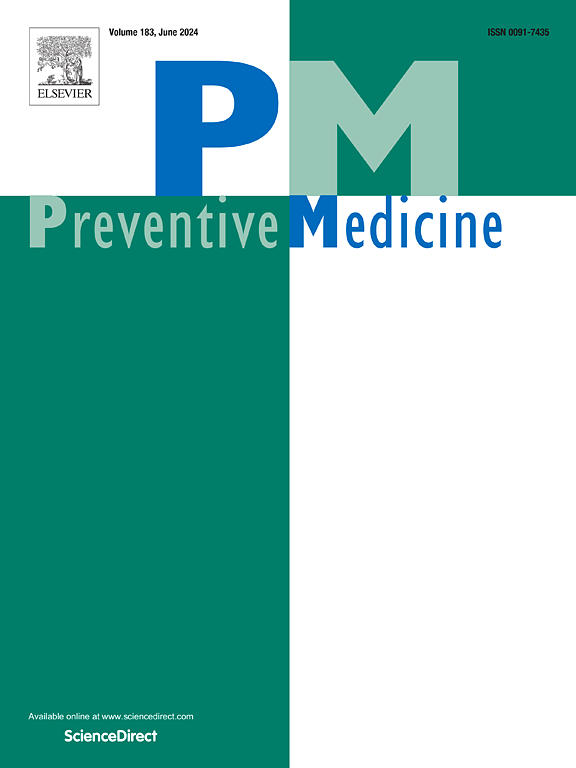Sustainable chronic disease prevention at scale: Evaluation of the Get Healthy Service, a telephone and online coaching service
IF 3.2
2区 医学
Q1 MEDICINE, GENERAL & INTERNAL
引用次数: 0
Abstract
Objective
The Get Healthy Service (GHS) is a free telephone and online health coaching service for adults delivered across New South Wales, Australia, since 2009. The GHS was first evaluated over 10 years ago and was shown to be effective. Using recent data, we investigated characteristics conducive to program completion and whether program impact has been sustained at scale.
Methods
This evaluation used data collected during program delivery between December 2017 and May 2023. Descriptive and inferential analysis was used to measure program completion, and pre-post health risk behaviour change.
Results
Of 53,566 participants enrolled in the GHS, 34 % completed the program. Multivariable analyses showed that men, people aged 50+ years, and those who did not identify as Aboriginal were more likely to complete the program. Program completers showed increased physical activity (43.5 mins/week; 95 % CI 40.55, 46.49), fruit intake (IRR 1.011; 95 % CI 1.08, 1.14) and vegetable intake (IRR 1.3; 95 % CI 1.27, 1.32); improvements in their BMI score (−0.51 kg/m2; 95 % CI -0.56, −0.45) and waist circumference (−2.74 cm; 95 % CI -2.96, −2.52); and improvements in sweet drink and takeaway food consumption. Compared to earlier evaluations, the impact of the GHS on health risk behaviours had decreased.
Conclusions
Since its launch almost 15 years ago, GHS continues to confer improved anthropometric and lifestyle risk factors in adults, however the magnitude of effect has decreased since earlier evaluations. Efforts to sustain and improve the impact of the program, particularly amongst participants from most disadvantaged backgrounds, is needed.
大规模的可持续慢性疾病预防:电话和在线指导服务“获得健康服务”的评估
目标健康服务(GHS)是自2009年以来在澳大利亚新南威尔士州为成年人提供的免费电话和在线健康指导服务。全球统一制度在10多年前首次得到评估,并证明是有效的。利用最近的数据,我们调查了有利于项目完成的特征,以及项目的影响是否在规模上持续。该评估使用了2017年12月至2023年5月期间项目交付期间收集的数据。采用描述性和推断性分析来衡量规划完成情况和前后健康风险行为的改变。结果在53566名参加GHS的参与者中,34%的人完成了该计划。多变量分析显示,男性、50岁以上的人以及不认为自己是原住民的人更有可能完成这个项目。计划完成者的身体活动增加(每周43.5分钟;95% CI 40.55, 46.49),水果摄入量(IRR 1.011;95% CI 1.08, 1.14)和蔬菜摄入量(IRR 1.3;95% ci 1.27, 1.32);BMI评分改善(- 0.51 kg/m2;95% CI -0.56, - 0.45)和腰围(- 2.74 cm;95% ci -2.96,−2.52);甜味饮料和外卖食品的消费也有所改善。与以前的评估相比,全球统一制度对健康风险行为的影响有所下降。自近15年前推出以来,GHS继续改善成人的人体测量和生活方式风险因素,然而,与早期评估相比,影响程度有所下降。需要努力维持和提高该方案的影响,特别是对来自最弱势背景的参与者的影响。
本文章由计算机程序翻译,如有差异,请以英文原文为准。
求助全文
约1分钟内获得全文
求助全文
来源期刊

Preventive medicine
医学-公共卫生、环境卫生与职业卫生
CiteScore
7.70
自引率
3.90%
发文量
0
审稿时长
42 days
期刊介绍:
Founded in 1972 by Ernst Wynder, Preventive Medicine is an international scholarly journal that provides prompt publication of original articles on the science and practice of disease prevention, health promotion, and public health policymaking. Preventive Medicine aims to reward innovation. It will favor insightful observational studies, thoughtful explorations of health data, unsuspected new angles for existing hypotheses, robust randomized controlled trials, and impartial systematic reviews. Preventive Medicine''s ultimate goal is to publish research that will have an impact on the work of practitioners of disease prevention and health promotion, as well as of related disciplines.
 求助内容:
求助内容: 应助结果提醒方式:
应助结果提醒方式:


